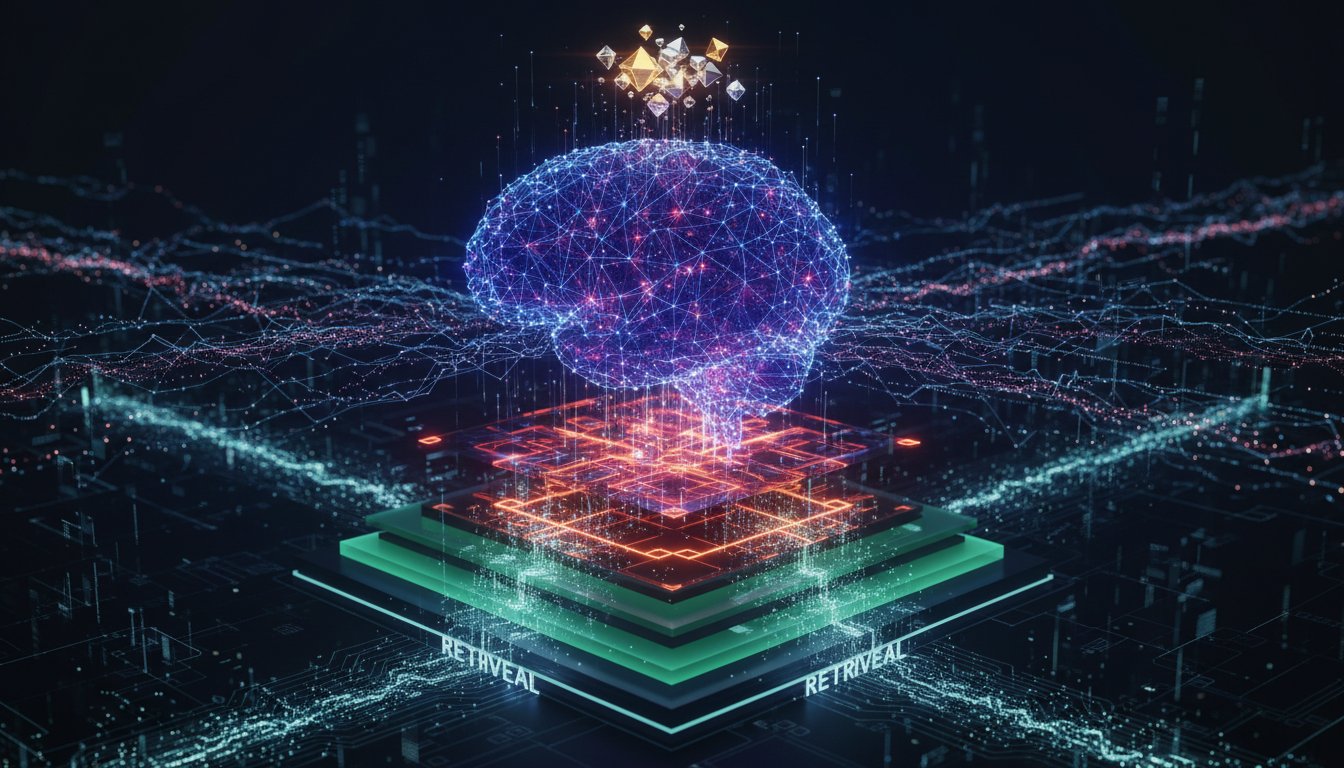Just Stumbled Upon a Game-Changer: An Intro to Cache-Enhanced RAG
In the relentless pursuit of artificial intelligence that is not only intelligent but also incredibly responsive, we often find ourselves at the frontier, scouting for the next breakthrough. Imagine deploying a sophisticated Retrieval Augmented Generation (RAG) system within your enterprise. It’s designed to provide nuanced, context-aware answers by drawing on vast proprietary datasets. Yet, users experience frustrating delays. The insights are brilliant, but the seconds ticking by as the system retrieves and processes information feel like an eternity. This latency, this friction point, is a common hurdle. As AI practitioners, we’re constantly asking: how can we make these powerful systems faster, more efficient, and ultimately, more valuable?
The challenge is multifaceted. RAG systems, by their very nature, perform complex operations. They sift through potentially terabytes of data, identify the most relevant snippets, and then feed this context to a Large Language Model (LLM) to generate a human-like response. Each step, from retrieval to generation, consumes time and computational resources. As enterprises scale their RAG deployments, these challenges are amplified, leading to increased operational costs and potentially impacting the user experience that these systems are designed to enhance. The core question then becomes: how do we optimize this intricate dance of data retrieval and language generation without compromising the quality of the output?
Fortunately, the AI landscape is one of perpetual innovation. Just when a challenge seems entrenched, a novel approach emerges. Today, we’re diving deep into one such innovation that promises to redefine RAG performance: Cache-Enhanced Retrieval Augmented Generation (CE-RAG). This isn’t merely an incremental improvement; it’s a strategic leap forward. As highlighted in recent industry analyses, techniques like cache-enhancement are pivotal for “boosting AI throughput,” addressing the critical needs for speed and efficiency head-on. This isn’t just about shaving off milliseconds; it’s about fundamentally altering the performance curve of RAG systems.
In this post, we’ll unpack Cache-Enhanced RAG. We’ll explore the persistent performance bottlenecks in traditional RAG architectures and why standard caching mechanisms often fall short. Then, we’ll introduce CE-RAG, detailing what it is, how it works, and the significant benefits it offers—from supercharged speed to substantial cost savings. Finally, we’ll touch upon key considerations for implementing this game-changing technology in your enterprise. Prepare to discover how intelligent caching is set to become an indispensable component of high-performance RAG.
The Persistent Challenge: Optimizing RAG Performance
Retrieval Augmented Generation has undeniably revolutionized how AI interacts with and utilizes large knowledge bases. By grounding LLMs in external, verifiable data, RAG systems deliver more accurate, relevant, and trustworthy responses. However, this power comes with inherent performance considerations that can become significant roadblocks, especially in enterprise-scale applications where speed and efficiency are paramount.
Understanding the Bottlenecks in Traditional RAG
Several factors contribute to latency and computational load in standard RAG pipelines:
- Retrieval Latency: The first crucial step in RAG is fetching relevant information. Searching through vast vector databases or document stores, even when highly optimized, takes time. The complexity of the query and the sheer volume of data can significantly impact how quickly the right context is identified. As Aithority notes, addressing speed is a key driver for advancements like cache-enhanced RAG.
- Computational Overhead of Generation Models: LLMs, while incredibly powerful, are computationally intensive. Generating a coherent and contextually appropriate response based on the retrieved information requires significant processing power. Each query to an LLM incurs this cost.
- Cost Implications: The operational costs of RAG systems can be substantial. This includes API call charges for proprietary LLMs (like those from OpenAI or Anthropic), as well as the compute resources needed for embedding, indexing, retrieval, and generation. Inefficient RAG systems can quickly become a financial drain.
- Data Processing and Preprocessing: Before data can even be retrieved, it needs to be chunked, embedded, and indexed. While often a one-time or periodic cost, inefficient handling here can impact overall system responsiveness and update cycles.
These bottlenecks collectively impact the user experience. Slow response times can lead to user frustration and abandonment, diminishing the value proposition of the RAG system, no matter how accurate its outputs.
Why Standard Caching Isn’t Always Enough
Caching, in general computing, is a well-established technique for improving performance by storing frequently accessed data closer to the point of use. However, applying traditional caching methods directly to RAG systems often yields limited benefits due to the unique nature of AI interactions:
- Dynamic Nature of Queries: Users rarely ask the exact same question twice. Queries can vary significantly in phrasing, intent, and the specific nuances of the information sought. Simple exact-match caching for queries is often ineffective.
- Semantic Complexity: RAG operates on semantic similarity. Two queries might be phrased differently but seek the same underlying information. A basic cache wouldn’t recognize this semantic equivalence.
- Constantly Evolving Data: In many enterprise scenarios, the underlying knowledge base for a RAG system is dynamic, with new documents added or existing ones updated frequently. A stale cache can provide outdated or incorrect information, undermining the reliability of the RAG system.
The limitations of conventional caching strategies in the RAG context necessitate a more intelligent, adaptive approach – paving the way for Cache-Enhanced RAG.
Introducing Cache-Enhanced RAG: The Next Leap Forward
As the demand for faster, more cost-effective RAG systems grows, innovation in optimization techniques is accelerating. Cache-Enhanced RAG (CE-RAG) represents a significant step in this direction, moving beyond simple data storage to intelligent reuse of computational effort and retrieved context. It’s about making RAG systems not just reactive, but proactively efficient.
What is Cache-Enhanced RAG?
Cache-Enhanced RAG is an advanced strategy that involves intelligently caching various components of the RAG pipeline—ranging from retrieved document chunks and their embeddings to the final generated responses—to serve similar future requests more rapidly and with lower computational cost. The core idea, as suggested by recent advancements reported by Aithority, is to significantly boost AI throughput and efficiency. This isn’t just about storing key-value pairs; it’s about understanding the semantic intent of queries and the contextual relevance of information to maximize cache hits for non-identical but semantically similar requests.
Think of it as a smart assistant for your RAG system. Instead of re-reading and re-processing the same or very similar source materials for every related question, the system leverages its ‘memory’ of past interactions. This ‘memory’ is the cache, but it’s designed with the nuances of natural language and information retrieval in mind.
How Does It Work? Key Mechanisms
Effective CE-RAG implementations employ several sophisticated mechanisms:
- Semantic Caching: This is arguably the cornerstone of CE-RAG. Instead of caching based on exact query matches, semantic caching stores results based on the meaning of the query. This involves converting incoming queries into embeddings and comparing them against embeddings of cached queries. If a new query is semantically similar enough to a cached query, the cached result (or parts of it, like retrieved documents) can be reused.
- Example: If one user asks, “What are the Q1 revenue figures for our software division?” and another asks, “Tell me about the first-quarter earnings of the software department,” a semantic cache could recognize the similarity and serve cached retrieved documents or even a previously generated summary, potentially bypassing a fresh database lookup and LLM call.
- Retrieved Context Caching: Frequently accessed document chunks or passages that are often retrieved together for certain types of queries can be cached. This speeds up the retrieval step for subsequent, similar information needs.
- Generated Response Caching: For queries that are identical or highly similar and whose underlying data hasn’t changed, the final LLM-generated response can be cached. This offers the most significant speed-up and cost saving for repeat questions.
- Adaptive Cache Invalidation and Update Strategies: Crucially, a CE-RAG system must have robust mechanisms to ensure cache freshness. When underlying documents are updated or new information becomes available, relevant cache entries must be invalidated or updated. Strategies can range from time-to-live (TTL) policies to event-driven invalidation triggered by data source changes.
- Tiered Caching: Some systems might implement multiple layers of caching—for instance, a fast in-memory cache for very hot data and a larger, slightly slower cache for less frequently accessed but still reusable items.
By strategically combining these mechanisms, Cache-Enhanced RAG aims to minimize redundant processing, reduce latency, and decrease the load on expensive LLM APIs and data retrieval systems.
The Tangible Benefits: Why Cache-Enhanced RAG Matters for Your Enterprise
The theoretical underpinnings of Cache-Enhanced RAG are compelling, but its true value lies in the concrete advantages it brings to enterprise AI deployments. Adopting CE-RAG isn’t just a technical upgrade; it’s a strategic move that can significantly impact efficiency, cost, and user satisfaction.
Supercharged Speed and Reduced Latency
This is often the most immediately noticeable benefit. By serving responses from a cache, CE-RAG can drastically cut down query response times.
- Faster User Experience: When a user’s query hits a relevant cache entry, the answer can be returned almost instantaneously, compared to the multi-second (or longer) delay of a full retrieval and generation cycle. This leads to a much smoother and more engaging user experience.
- Increased Throughput: As highlighted by industry reports focusing on “boosting AI throughput,” faster processing per query means the system can handle a higher volume of queries within the same timeframe using the same hardware. This is critical for systems with many concurrent users.
- Data Point (Illustrative): While specific benchmarks depend on implementation, it’s conceivable for well-tuned CE-RAG systems to reduce average latency for common queries by 50-80% or even more.
Significant Cost Savings
Computational resources and API calls form a major part of RAG operational expenses. CE-RAG directly addresses this.
- Reduced LLM API Calls: Each time a response is served from the cache, it potentially avoids a call to an expensive LLM API. For enterprises processing thousands or millions of queries, these savings accumulate rapidly. Consider a popular internal Q&A bot: if 20% of daily queries are semantically similar and can be served from a cache, the LLM costs associated with those queries are virtually eliminated.
- Lower Computational Resource Consumption: Less reliance on the full RAG pipeline means reduced CPU/GPU usage for embedding, retrieval, and generation. This translates to lower infrastructure costs or more capacity from existing hardware.
- Example: An enterprise RAG system serving customer support might find that common product troubleshooting questions make up a large portion of queries. Caching the retrieved solution documents and even templated responses for these can lead to substantial daily savings on LLM tokens and compute instances.
Improved Scalability
By alleviating bottlenecks, CE-RAG enhances the overall scalability of the RAG system.
- Handling Peak Loads: Caching helps absorb spikes in query volume without requiring immediate scaling of the entire backend infrastructure. The system becomes more resilient and performs more consistently under pressure.
- Efficient Resource Utilization: Resources are freed up to handle novel or more complex queries that genuinely require the full power of the RAG pipeline, rather than being consumed by repetitive tasks.
Enhanced User Experience and Consistency
Beyond speed, caching can also improve the quality and consistency of interactions.
- Consistent Answers: For similar queries, users receive consistent information, which is particularly important for factual Q&A or policy-related information.
- Reduced System Load leading to Reliability: By lessening the strain on downstream components (databases, LLMs), caching can contribute to overall system stability and reliability.
Implementing CE-RAG transforms a RAG system from a powerful but potentially cumbersome tool into a sleek, highly efficient information delivery engine. The benefits ripple across the organization, from happier users to a healthier IT budget.
Implementing Cache-Enhanced RAG: Considerations and Best Practices
Adopting Cache-Enhanced RAG is a strategic decision that can yield substantial benefits, but like any advanced technology, its successful implementation requires careful planning and consideration of various architectural and operational aspects. It’s not a one-size-fits-all solution; the optimal CE-RAG setup will depend on the specific use case, data characteristics, and performance goals.
Key Architectural Components
A robust CE-RAG system typically involves integrating several key components:
- The Cache Store: This is where cached items (embeddings, document chunks, generated responses) are stored. Options range from general-purpose in-memory datastores like Redis (known for speed) to specialized vector databases that can efficiently store and query embeddings for semantic caching. The choice depends on factors like scale, persistence requirements, and query patterns.
- Semantic Similarity Module: For semantic caching, a module is needed to convert incoming queries into embeddings and compare them against the embeddings of cached queries. This often leverages the same embedding models used in the RAG system’s retrieval phase.
- Cache Management Logic: This is the brain of the CE-RAG system. It decides what to cache, when to cache it, how to index it for efficient lookup (e.g., using query embeddings as keys), and, crucially, when to evict or invalidate cache entries. This logic needs to balance cache hit rates with data freshness.
- Integration with RAG Pipeline: The caching layer must be seamlessly integrated into the existing RAG workflow. Typically, it sits before the main retrieval and generation stages, intercepting queries to check the cache first.
Choosing the Right Caching Strategy
The effectiveness of CE-RAG hinges on the chosen caching strategy. Key considerations include:
- What to Cache:
- Retrieved Documents/Chunks: Caching the relevant text snippets retrieved from the knowledge base can save on repeated searches, especially if the generation step needs to be dynamic.
- Intermediate LLM Calls: If a RAG process involves multiple LLM calls (e.g., query rewriting, then answer generation), caching intermediate results can be beneficial.
- Final Generated Responses: Offers the biggest performance gain for identical or very similar queries, but requires careful handling of personalization and data freshness.
- Cache Invalidation: This is critical. Stale cache entries can provide outdated or incorrect information. Strategies include:
- Time-To-Live (TTL): Simple, but may not reflect actual data changes.
- Event-Driven Invalidation: Triggered by updates to the underlying data sources. More complex but more accurate.
- Active Checking: Periodically re-validating cached items against source data.
- Semantic Thresholds: For semantic caching, defining the right similarity threshold is important. Too low, and the cache hit rate will be poor; too high, and irrelevant information might be served.
Potential Challenges and Best Practices
While powerful, CE-RAG implementation comes with its own set of challenges:
- Cache Coherency: Ensuring the cache remains consistent with rapidly changing data sources is paramount, especially for enterprise systems where data integrity is key.
- Complexity: Implementing effective semantic caching and sophisticated invalidation logic can be complex and require specialized expertise.
- ‘Cold Start’ Problem: A new system or a freshly cleared cache will initially have low hit rates until it’s ‘warmed up’ with sufficient query traffic.
- Measuring Effectiveness: Setting up proper monitoring and analytics to track cache hit rates, latency improvements, and cost savings is essential to justify and optimize the CE-RAG system.
Best Practices:
* Start Simple, Iterate: Begin with caching the most impactful and easiest-to-manage items (e.g., exact matches for high-frequency queries or commonly retrieved documents) and gradually introduce more sophisticated semantic caching.
* Monitor and Tune: Continuously monitor cache performance and adjust strategies (e.g., TTLs, semantic thresholds) based on observed patterns.
* Prioritize Freshness for Critical Data: For highly sensitive or rapidly changing information, prioritize freshness over aggressive caching, or implement robust, near real-time invalidation.
* Consider Hybrid Approaches: Combine different caching techniques (e.g., exact match, semantic, document-level) for different types of content or queries.
One of the unspoken rules of efficient RAG is evolving; it’s no longer just about smart retrieval but also about smart reuse. Intelligent caching, as embodied by CE-RAG, is rapidly becoming a cornerstone of that philosophy.
Conclusion: The Cached Future of RAG
The journey of Retrieval Augmented Generation is one of continuous refinement, driven by the need to make AI interactions more intelligent, context-aware, and efficient. We began by acknowledging the performance hurdles—latency, cost, and scalability—that can temper the brilliance of even the most advanced RAG systems. These challenges, while significant, are not insurmountable, especially with innovative approaches like Cache-Enhanced RAG entering the fray.
CE-RAG offers a compelling solution, moving beyond traditional caching paradigms to embrace semantic understanding and intelligent reuse of computational efforts. By strategically caching retrieved information and generated responses, it directly tackles the core bottlenecks, delivering supercharged speed, notable cost savings, and enhanced scalability. This isn’t just a marginal gain; it’s a pathway to transforming the user experience and unlocking greater ROI from enterprise AI investments. As we’ve seen, the mechanisms—from semantic caching to adaptive invalidation—are sophisticated, but the outcome is simple: a faster, leaner, and more responsive RAG system.
Indeed, discovering Cache-Enhanced RAG feels like uncovering a powerful new capability in our AI toolkit, promising to make our RAG systems not just smarter, but significantly faster and more efficient. As enterprise adoption of RAG continues to accelerate, techniques that optimize performance and cost-effectiveness will become not just advantageous, but essential. Cache-Enhanced RAG is undoubtedly at the forefront of this evolution.
What are your thoughts on the potential of Cache-Enhanced RAG? Have you experimented with similar techniques in your RAG deployments? Share your insights and experiences in the comments below, or explore our other deep-dives into cutting-edge RAG technologies and enterprise AI strategies on ragaboutit.com!




